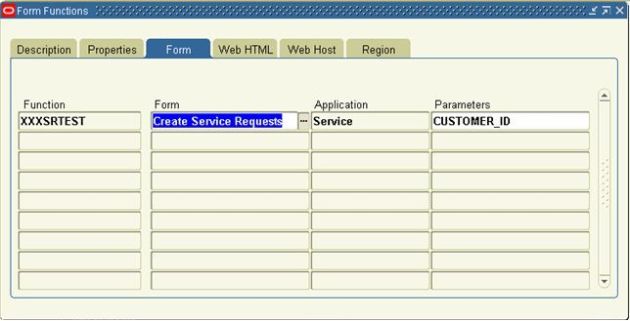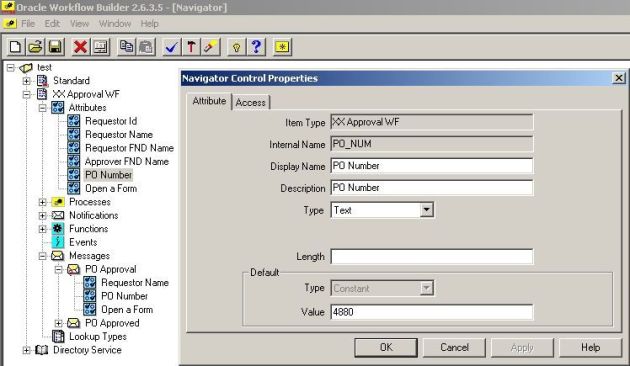It is quite an easy task to enable a user to
open a Form directly from an Oracle Workflow Notifications page. In
fact, we can also pass parameters to the form so that it automatically
queries the form and displays a record based on the parameter which is
passed. This post demonstrates how this is done. Along the way we will
also look at a small but pretty useful trick – clicking a button through
Form Personalization.
Following are the basic steps:
- Register a form function as per requirement
- Create an attribute of type ‘Form’ which stores the name of the form function and the parameter with which we want to call it.
- In a workflow process include a notification message.
- Associate the attribute with the notification message

Since the Find Service Request function does not accept any parameters, first I will register my own function(XXXSRTEST) based on the seeded form so that my function will be able to accept the parameter which I will pass to it from the Workflow.

As you can see from the following screen shots, the only difference between my function and the seeded Find Service Request function(CSXSRISV) is that my function can accept the CUSTOMER_ID parameter.

Add the function to the appropriate menu so that it is accessible from the responsibility from where the Workflow Notifications will be viewed. Now I will open the function and personalize it so that the parameter that I pass is populated in the appropriate field and the Search button is clicked automatically. I create the following personalization rule:
Seq:10
Description:Accept parameter and execute query
Condition
Trigger Event:WHEN-NEW-FORM-INSTANCE
Trigger Object:None
Condition:None
Processing Mode:Not In Enter-Query Mode
Context:
Level: Site
Then I add three actions to the rule. In the first action(seq#20), I populate the appropriate field in the form with the value stored in the parameter which I created for this function. During runtime, I will pass a value to this parameter from the Workflow.

In the second(seq#30) and third actions(seq#31) I click the Search button automatically through personalization. First I shift focus to the Search button using the ‘GO_ITEM’ builtin.

Then I call the EXECUTE_TRIGGER builtin with argument WHEN-BUTTON-PRESSED to simulate the button press.

Once these personalizations are done, I will make the function inaccessible from the front end by removing the prompt name for the function from the menu.
In the Workflow, I add two attributes – ‘PO Number’ and ‘Open a Form’. ‘PO Number’ is a text type attribute which is set to a value of 4880(this is the parameter which I will pass to my form) and it has the internal name ‘PO_NUM’

‘Open a Form’ is an attribute of type ‘Form’ and it is set to a value XXXSRTEST:CUSTOMER_ID=&PO_NUM. The value indicates that the form function to be opened is XXXSRTEST with the parameter CUSTOMER_ID. The value stored in the attribute PO_NUM will be passed to the parameter.

Create a message and associate both these attributes with the message. Attach the message to a notification.Associating a ‘Form’ type attribute with the notification message displays a link in the Notification at runtime which can be clicked to open the Form.

Run the Workflow and open the notifications page. You will see a link in the ‘References’ sections with the same name as that of the ‘Form’ type attribute.

Clicking on the link opens my custom function ‘XXXSRTEST’ while passing the value 4880(stored in the PO Number attribute) to parameter CUSTOMER_ID. The personalizations in the function populates the Service Request Number field with the value of the parameter and automatically clicks on the Search button to execute the query and the appropriate record is displayed.

Note:
- The form function will open automatically only if it is accessible from the same responsibility from which the Workflow Notification is viewed otherwise it will prompt you to choose the responsibility manually.
- The syntax for accessing a form with parameters may vary depending upon the EBS version, in my instance XXXSRTEST:CUSTOMER_ID=&PO_NUM works. If it doesn’t work in your system try using XXXSRTEST:CUSTOMER_ID=’&PO_NUM’ or XXXSRTEST:CUSTOMER_ID=”&PO_NUM”.
No comments:
Post a Comment